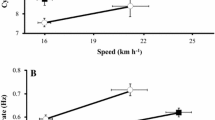Abstract
In the last fifteen years, a trend has appeared in cross-country ski racing to increase the use of double poling and, therefore, to increase the load on the shoulder girdle (arm) muscles. The purpose of this study was to compare the aerobic performance of elite cross-country skiers in incremental running (treadmill) and double poling (with manual ski ergometer) tests to exhaustion. Four junior cross-country skiers and four biathletes (\( \dot V_{O_{2max} } \) = 70 (66–72) mL/min per kg body weight) participated in the experiment. In the double poling test, the lactate concentration increased more rapidly than in the running test, and the peak oxygen consumption (\( \dot V_{O_{2peak} } \)) in the double poling test was 88 (84–93)% of the maximal oxygen consumption (\( \dot V_{O_{2max} } \)) in the running test. The relative anaerobic threshold, which characterizes the relative level of current aerobic performance, in the double poling test was significantly lower than in the running test (79 (57–83)% vs 94 (90–98)%, respectively). On the basis of these data, it can be concluded that the main reserve for a further increase in the aerobic performance of cross-country skiers and biathletes is the increase in the aerobic capacity of arm and trunk muscles.
Similar content being viewed by others
References
Komi, P.V., Ito, A., Sjodin, B., et al., Muscle Metabolism, Lactate Breaking Point, and Biomechanical Features of Endurance Running, Int. J. Sports Med., 1981, vol. 2, no. 3, p. 148.
Mader, A., Evaluation of the Endurance Performance of Marathon Runners and Theoretical Analysis of Test Results, J. Sports Med. Phys. Fitness, 1991, vol. 31, no. 1, p. 1.
Popov, D.V., Bravyi, Ya.R., Lemesheva, Yu.S., et al., Forecasting of Sports Results of Skaters by a Comprehensive Morphophysiological Examination, Teor. Prakt. Fiz. Kul’t., 2008, no. 9, p. 40.
Seluyanov, V.N., Podgotovka beguna na srednie distantsii (Preparation of a Middle Distance Runner), Moscow: SportAkademPress, 2001.
Daniels, J.T., Yarbrough, R.A., and Foster, C., Changes in VO2 Max and Running Performance with Training, Eur. J. Appl. Physiol. Occup. Physiol., 1978, vol. 39, no. 4, p. 249.
Denis, C., Fouquet, R., Poty, P., et al., Effect of 40 Weeks of Endurance Training on the Anaerobic Threshold, Int. J. Sports Med., 1982, vol. 3, no. 4, p. 208.
Lindinger, S.J., Stoggl, T., Muller, E., et al., Control of Speed during the Double Poling Technique Performed by Elite Cross-Country Skiers, Med. Sci. Sports Exerc., 2009, vol. 41, no. 1, p. 210.
Nesser, T.W., Chen, S., Serfass, R.C., et al., Development of Upper Body Power in Junior Cross-Country Skiers, J. Strength Cond. Res., 2004, vol. 18, no. 1, p. 63.
Alsobrook, N.G. and Heil, D.P., Upper Body Power as a Determinant of Classical Cross-Country Ski Performance, Eur. J. Appl. Physiol., 2009, vol. 105, no. 4, p. 633.
Fabre, N., Balestreri, F., Leonardi, A., et al., Racing Performance and Incremental Double Poling Test on Treadmill in Elite Female Cross-Country Skiers, J. Strength Cond. Res., 2010, vol. 24, no. 2, p. 401.
van Hall, G., Jensen-Urstad, M., Rosdahl, H., et al., Leg and Arm Lactate and Substrate Kinetics during Exercise, Am. J. Physiol. Endocrinol. Metab., 2003, vol. 284, no. 1, p. E193.
Mygind, E., Fibre Characteristics and Enzyme Levels of Arm and Leg Muscles in Elite Cross-Country Skiers, Scand. J. Med. Sci. Sports, 1995, vol. 5, no. 2, p. 76.
Calbet, J.A., Holmberg, H.C., Rosdahl, H., et al., Why Do Arms Extract Less Oxygen Than Legs during Exercise?, Am. J. Physiol. Regul. Integr. Comp. Physiol., 2005, vol. 289, no. 5, p. R1448.
Kindermann, W., Simon, G., and Keul, J., The Significance of the Aerobic-Anaerobic Transition for the Determination of Work Load Intensities during Endurance Training, Eur. J. Appl. Physiol. Occup. Physiol., 1979, vol. 42, no. 1, p. 25.
Marcinek, D.J., Kushmerick, M.J., and Conley, K.E., Lactic Acidosis In Vivo: Testing the Link between Lactate Generation and H+ Accumulation in Ischemic Mouse Muscle, J. Appl. Physiol., 2010, vol. 108, no. 6, p. 1479.
Chase, P.B. and Kushmerick, M.J., Effects of pH on Contraction of Rabbit Fast and Slow Skeletal Muscle Fibers, Biophys. J., 1988, vol. 53, no. 6, p. 935.
Fitts, R.H., The Cross-Bridge Cycle and Skeletal Muscle Fatigue, J. Appl. Physiol., 2008, vol. 104, no. 2, p. 551.
Conley, K.E., Kushmerick, M.J., and Jubrias, S.A., Glycolysis Is Independent of Oxygenation State in Stimulated Human Skeletal Muscle In Vivo, J. Physiol., 1998, vol. 511, p. 935.
Richardson, R.S., Noyszewski, E.A., Leigh, J.S., et al., Lactate Efflux from Exercising Human Skeletal Muscle: Role of Intracellular PO2, J. Appl. Physiol., 1998, vol. 85, no. 2, p. 627.
Terzis, G., Stattin, B., and Holmberg, H.C., Upper Body Training and the Triceps Brachii Muscle of Elite Cross Country Skiers, Scand. J. Med. Sci. Sports, 2006, vol. 16, no. 2, p. 121.
Bjorklund, G., Stoggl, T., and Holmberg, H.C., Biomechanically Influenced Differences in O2 Extraction in Diagonal Skiing: Arm versus Leg, Med. Sci. Sports Exerc., 2010, vol. 42, no. 10, p. 1899.
Gayeski, T.E. and Honig, C.R., O2 Gradients from Sarcolemma to Cell Interior in Red Muscle at Maximal VO2, Am. J. Physiol., 1986, vol. 251, no. 4, p. H789.
Kayar, S.R., Hoppeler, H., Jones, J.H., et al., Capillary Blood Transit Time in Muscles in Relation to Body Size and Aerobic Capacity, J. Exp. Biol., 1994, vol. 194, p. 69.
Wagner, P.D., Diffusive Resistance to O2 Transport in Muscle, Acta Physiol. Scand., 2000, vol. 168, no. 4, p. 609.
Bassett, D.R., Jr. and Howley, E.T., Limiting Factors for Maximum Oxygen Uptake and Determinants of Endurance Performance, Med. Sci. Sports Exerc., 2000, vol. 32, no. 1, p. 70.
Author information
Authors and Affiliations
Additional information
Original Russian Text © D.V. Popov, O.L. Vinogradova, 2012, published in Fiziologiya Cheloveka, 2012, Vol. 38, No. 5, pp. 67–72.
Rights and permissions
About this article
Cite this article
Popov, D.V., Vinogradova, O.L. Comparison of the aerobic performance of leg and arm muscles in cross-country skiers. Hum Physiol 38, 508–513 (2012). https://doi.org/10.1134/S0362119712050106
Received:
Published:
Issue Date:
DOI: https://doi.org/10.1134/S0362119712050106



